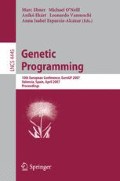Abstract
Speech quality, as perceived by the users of Voice over Internet Protocol (VoIP) telephony, is critically important to the uptake of this service. VoIP quality can be degraded by network layer problems (delay, jitter, packet loss). This paper presents a method for real-time, non-intrusive speech quality estimation for VoIP that emulates the subjective listening quality measures based on Mean Opinion Scores (MOS). MOS provide the numerical indication of perceived quality of speech. We employ a Genetic Programming based symbolic regression approach to derive a speech quality estimation model. Our results compare favorably with the International Telecommunications Union-Telecommunication Standardization (ITU-T) PESQ algorithm which is the most widely accepted standard for speech quality estimation. Moreover, our model is suitable for real-time speech quality estimation of VoIP while PESQ is not. The performance of the proposed model was also compared to the new ITU-T recommendation P.563 for non-intrusive speech quality estimation and an improved performance was observed.
Access this chapter
Tax calculation will be finalised at checkout
Purchases are for personal use only
Preview
Unable to display preview. Download preview PDF.
References
ITU-T: Methods for subjective determination of transmission quality. International Telecommunications Union, Geneva, Switzerland. ITU-T Recommendation P.800 (1996)
ITU-T: Perceptual evaluation of speech quality (PESQ), an objective method for end-to-end speech quality assessment of narrowband telephone networks and speech codecs. International Telecommunications Union, Geneva, Switzerland. ITU-T Recommendation P.862 (2001)
ITU-T: Single-ended method for objective speech quality assessment in narrow-band telephony applications. International Telecommunications Union, Geneva, Switzerland. ITU-T Recommendation P.563 (2005)
ITU-T: The E-Model, a computational model for use in transmission planning. International Telecommunications Union, Geneva, Switzerland. ITU-T Recommendation G.107 (1998)
ITU-T: Methodology for Derivation of Equipment Impairment Factors From Subjective Listening-Only Tests. International Telecommunications Union, Geneva, Switzerland. ITU-T Recommendation P.833 (2001)
Sun, L.F., Ifeachor, E.C.: perceived speech quality prediction for voice over ip-based networks. In: IEEE International Conference on Communications (ICC), vol. 4, pp. 2573–2577. IEEE, Los Alamitos (2002)
Mohamed, S., Cervantes-Perez, F., Afifi, H.: Integrating networks measurements and speech quality subjective scores for control purposes. In: Annual Joint Conference of the IEEE Computer and Communications Societies (INFOCOM), pp. 641–649. IEEE Computer Society Press, Los Alamitos (2001)
Mohamed, S., Rubino, G., Varela, M.: A method for quantitative evaluation of audio quality over packet networks and its comparison with existing techniques. In: Measurement of Speech and Audio Quality in Networks (MESAQIN) (2004)
Hoene, C., Karl, H., Wolisz, A.: A perceptual quality model for adaptive voip applications. In: Proc. of International Symposium on Performance Evaluation of Computer and Telecommunication Systems (SPECTS), San Jose, California, USA (2004)
Pennock, S.: Accuracy of the perceptual evaluation of speech quality (pesq) algorithm. In: Measurement of Speech and Audio Quality in Networks (MESAQIN) (2002)
Sun, L.F., Ifeachor, E.C.: Subjective and objective speech quality evaluation under bursty losses. In: Measurement of Speech and Audio Quality in Networks (MESAQIN) (2002)
ITU-T: Network model for evaluating multimedia transmission performance over internet protocol. International Telecommunications Union, Geneva, Switzerland. ITU-T Recommendation G.1050 (2005)
ITU-T: Coding of Speech at 8 kbit/s using conjugate-structure algebraic-code-excited linear-prediction (CS-ACELP). International Telecommunications Union, Geneva, Switzerland. ITU-T Recommendation G.729 (1996)
ETSI EN 301 704 V7.2.1: Digital cellular telecommunications system; Adaptive Multi-Rate (AMR) speech transcoding
ITU-T: Dual rate speech coder for multimedia communication transmitting at 5.3 and 6.3 kbit/s. International Telecommunications Union, Geneva, Switzerland. ITU-T Recommendation G.723.1 (1996)
ITU-T: Mean opinion score (MOS) terminology. International Telecommunications Union, Geneva, Switzerland. ITU-T Recommendation P.800.1 (2003)
Chu, W.C.: Speech Coding Algorithms: Foundation and Evolution of Standardized Codecs. John Wiley and Sons Inc., New York (2003)
Davis, L.: Adapting operator probabilities in genetic algorithms. In: Proceedings of the Third International Conference on Genetic Algorithms, San Mateo, CA (1989)
Luke, S., Panait, L.: Lexicographic parsimony pressure. In: W.B.L., et al. (eds.) GECCO 2002: Proceedings of the Genetic and Evolutionary Computation Conference, New York, pp. 829–836 (2002)
Keijzer, M.: Scaled symbolic regression. Genetic Programming and Evolvable Machines 5(3), 259–269 (2004)
Gustafson, S., Burke, E.K., Krasnogor, N.: On improving genetic programming for symbolic regression. In: Proceedings of the 2005 IEEE Congress on Evolutionary Computation. IEEE Computer Society Press, Los Alamitos (2005)
ITU-T: Subjective performance assessment of telephone-band and wideband digital codecs. International Telecommunications Union, Geneva, Switzerland. ITU-T Recommendation P.830 (1996)
Author information
Authors and Affiliations
Editor information
Rights and permissions
Copyright information
© 2007 Springer Berlin Heidelberg
About this paper
Cite this paper
Raja, A., Azad, R.M.A., Flanagan, C., Ryan, C. (2007). Real-Time, Non-intrusive Evaluation of VoIP. In: Ebner, M., O’Neill, M., Ekárt, A., Vanneschi, L., Esparcia-Alcázar, A.I. (eds) Genetic Programming. EuroGP 2007. Lecture Notes in Computer Science, vol 4445. Springer, Berlin, Heidelberg. https://doi.org/10.1007/978-3-540-71605-1_20
Download citation
DOI: https://doi.org/10.1007/978-3-540-71605-1_20
Publisher Name: Springer, Berlin, Heidelberg
Print ISBN: 978-3-540-71602-0
Online ISBN: 978-3-540-71605-1
eBook Packages: Computer ScienceComputer Science (R0)

